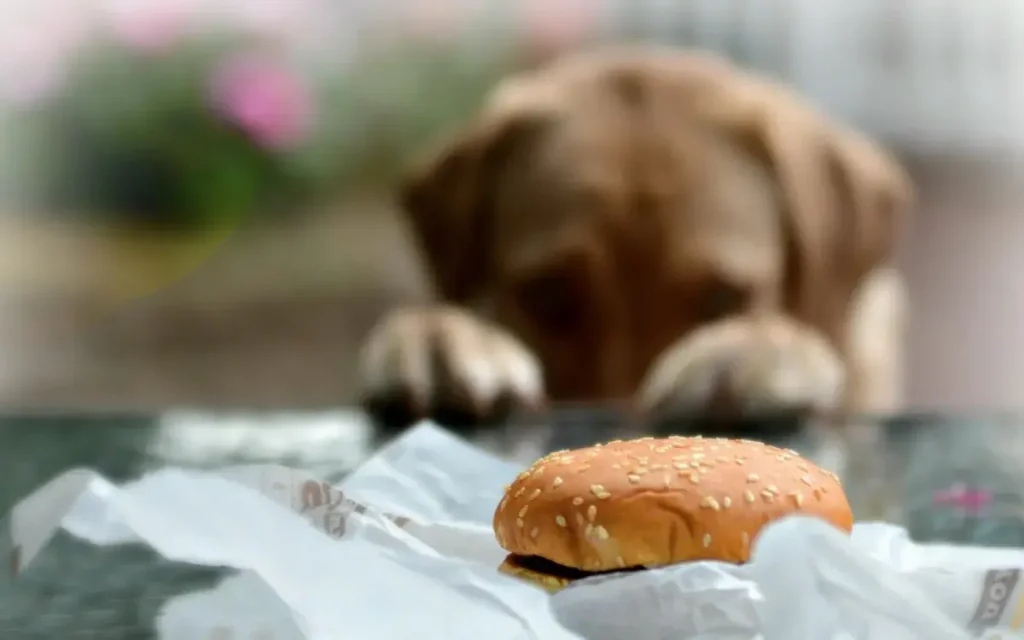A Burger Bandit’s Swift Strike: When Dogs Take Fast Food Into Their Own Paws
What was meant to be a simple journey home with a McDonald’s meal turned into an unexpected comedy of canine cunning for one dog owner. The now-viral moment, captured on home security footage and shared on TikTok, shows a cocker spaniel named Tiki executing what can only be described as the perfect fast-food heist. As the unsuspecting owner approached her front door, burger in hand, Tiki saw an opportunity and seized it – quite literally. With impeccable timing and surprising agility, the spaniel leapt into the air and snatched the burger directly from her owner’s grip. The owner, clearly taken aback but finding humor in the situation, captioned her video with a tongue-in-cheek plea to McDonald’s: “Can I have a voucher for a new burger?” What followed was an outpouring of comments from viewers who overwhelmingly sided with the four-legged culprit, suggesting that holding a tempting burger at such a height in the presence of a food-motivated dog was practically an invitation for theft.
The internet’s reaction to Tiki’s mid-air burger heist was both swift and overwhelmingly supportive of the canine criminal. Rather than sympathizing with the owner’s loss of lunch, commenters playfully assigned blame to the human for what they considered a tactical error. “As a spaniel fan, holding it at that height was entirely your own downfall,” observed one viewer, while another suggested the owner had practically guided the food into her dog’s mouth. The comment section transformed into a court of public opinion where Tiki was unanimously acquitted of any wrongdoing. Some commenters even reimagined the scenario as one of helpfulness rather than theft, with one person translating Tiki’s possible thought process: “You only got two hands, let me help you with that burger.” The collective response highlighted how pet owners often find themselves more amused than annoyed by their companions’ mischievous behavior, especially when it’s executed with such precision.
While Tiki’s burger snatch might seem like an isolated incident of opportunistic theft, it actually represents a broader behavior pattern familiar to many dog owners. The American Kennel Club identifies this type of food pilfering as part of a common canine tendency known as “counter-surfing” – the practice of dogs attempting to score forbidden treats from kitchen counters and tables. Though Tiki’s approach was more direct than the traditional counter-surfing technique, it stems from the same natural instinct: dogs are opportunistic eaters by nature and have evolved keen senses for detecting and obtaining food. What’s particularly interesting about Tiki’s case is that while counter-surfing is often associated with larger breeds who can easily reach countertops, the AKC notes that dogs of all sizes may engage in food theft, with some smaller dogs even developing impressive jumping abilities specifically for this purpose.
The impulse to steal human food may seem amusing in videos like Tiki’s burger heist, but canine food theft presents genuine concerns for pet owners. Beyond the inconvenience of losing a meal, there are significant health risks when dogs consume foods that may be harmful or toxic to them. Onions, chocolate, artificial sweeteners, and certain spices commonly found in human food can cause serious health problems for dogs. The AKC emphasizes the importance of prevention rather than correction when it comes to food-stealing behaviors. Once a dog experiences the reward of successfully obtaining human food, the behavior becomes self-reinforcing and considerably more difficult to eliminate. This is why experts recommend proactive measures: never leaving food unattended, keeping counters clear of even small crumbs that might entice a curious canine, and being particularly vigilant during food preparation or when carrying meals through areas accessible to pets.
For dog owners struggling with food-thieving pets like Tiki, behaviorists recommend a two-pronged approach focused on management and training. The management aspect involves controlling the environment by limiting the dog’s access to areas where food is prepared or consumed, especially during vulnerable moments when supervision isn’t possible. The training component requires teaching and consistently reinforcing alternative behaviors that are incompatible with food stealing. For instance, training a dog to go to a designated spot during meal preparation or providing appropriate food-stuffed toys in another room can redirect their attention and energy. Positive reinforcement plays a crucial role here – rewarding the desired behaviors generously helps establish new habits that eventually replace the problematic ones. Some owners have found success with specific cues like “leave it” or “off,” but these commands require consistent practice in progressively challenging scenarios before they can be reliable in high-temptation situations.
Tiki’s McDonald’s misadventure ultimately represents the charming reality of living with dogs: they are creatures of both intelligence and impulse, capable of calculating the perfect moment to strike for something they desire. While the owner may have lost her burger that day, she gained something possibly more valuable – a moment of pure canine authenticity captured on camera and shared with thousands of amused viewers who recognized in Tiki’s behavior something familiar and endearing about our four-legged companions. As pet owners, we often find ourselves simultaneously frustrated by and enamored with these moments of mischief. They remind us that despite our best efforts at training and despite the domestication that has made dogs our closest animal companions, they maintain their own agenda and priorities – chief among them being the pursuit of tasty opportunities, even when they arrive in the form of a fast-food burger held at precisely the wrong height by an unsuspecting human.















